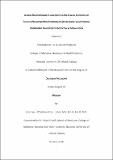| dc.contributor.advisor | Sharif, Faisal | |
| dc.contributor.author | O'Sullivan, Crochan | |
| dc.date.accessioned | 2016-01-15T10:37:18Z | |
| dc.date.available | 2016-01-15T10:37:18Z | |
| dc.date.issued | 2016-01-12 | |
| dc.identifier.uri | http://hdl.handle.net/10379/5456 | |
| dc.description.abstract | The present thesis is comprised of an introduction followed by eight chapters. The introduction gives an overview of the transcatheter aortic valve implantation (TAVI) procedure and details the patient selection process. Chapter 1 reviews the methods of determining aortic stenosis (AS) heamodynamic severity and the pros and cons of using transthoracic echocardiography versus an invasive evaluation. Severe AS may be divided into three subtypes, namely, 1) high gradient AS, 2) “paradoxical” low-flow, low-gradient severe AS, and 3) low ejection fraction, low-gradient (LEF-LG) severe AS. Chapter 2 assesses the clinical outcomes of patients undergoing TAVI according to this new classification system. Chapter 3 further explores the flow-gradient classification of severe AS as proposed by Dumesnil et al. The majority of patients presenting with symptomatic severe AS have concomitant coronary artery disease (CAD), and the appropriate management of this condi-tion is an important consideration in the overall management of patients presenting with sympto-matic severe AS. Chapter 4 provides a comprehensive overview of the management of concomi-tant CAD among patients presenting with symptomatic severe AS. Chapter 5 and chapter 6 deal with the high-risk subset of patients presenting with LEF-LG severe AS. Patients presenting with the latter condition have a high prevalence of concomitant CAD, and chapter 5 attempts to address the optimal strategy for managing these patients. Patients presenting with LEF-LG severe AS also have a high prevalence of concomitant moderate to severe mitral regurgitation (MR) and chapter 6 assesses the effect of MR on clinical outcomes after TAVI. A new classification for pulmonary hy-pertension was recently proposed and chapter 7 investigates whether this system may be useful for further risk stratification of patients undergoing TAVI. Finally, chapter 8 investigates the impact of B-type natriuretic peptide on short term clinical outcomes after TAVI. | en_IE |
| dc.rights | Attribution-NonCommercial-NoDerivs 3.0 Ireland | |
| dc.rights.uri | https://creativecommons.org/licenses/by-nc-nd/3.0/ie/ | |
| dc.subject | Aortic stenosis | en_IE |
| dc.subject | TAVI | en_IE |
| dc.subject | Mitral regurgitation | en_IE |
| dc.subject | Pulmonary hypertension | en_IE |
| dc.subject | Haemodynamics | en_IE |
| dc.subject | Medicine | en_IE |
| dc.subject | Medicine, Nursing & Health Sciences | en_IE |
| dc.title | Invasive haemodynamic characteristics and clinical outcomes of patients presenting with symptomatic severe aortic valve stenosis undergoing transcatheter aortic valve implantation | en_IE |
| dc.type | Thesis | en_IE |
| dc.local.note | Aortic valve stenosis is one of the most common diseases to affect heart valves in the western world and is the most common reason patients undergo surgery for valve disease. Transcatheter aortic valve implantation is a new technique that can be used to treat elderly patients who were previously considered too high risk or inoperable. The present thesis evaluated risk stratification tools to help select the best patients to undergo this transformative procedure. | en_IE |
| dc.local.final | Yes | en_IE |
| nui.item.downloads | 1231 | |


